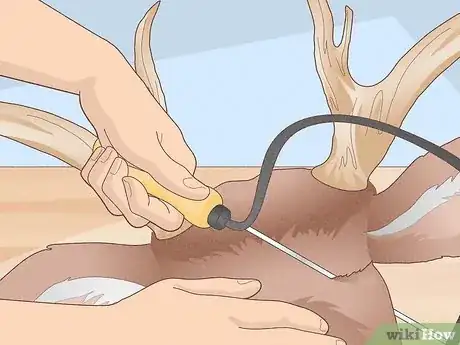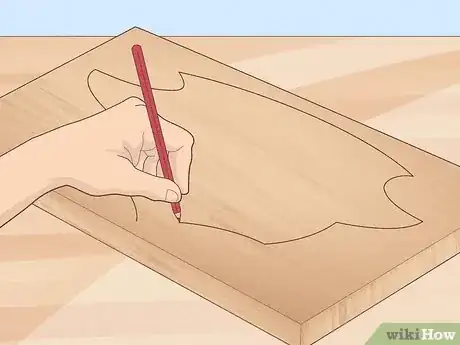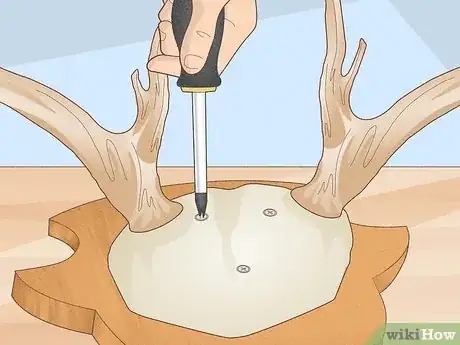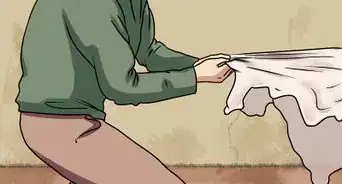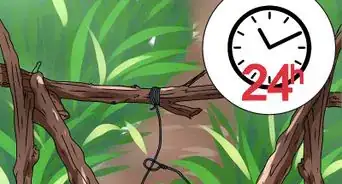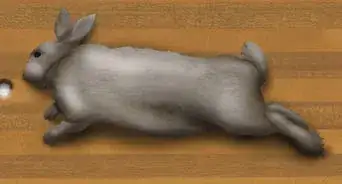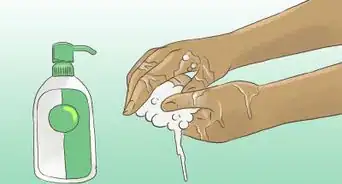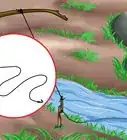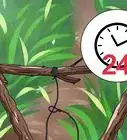This article was co-authored by wikiHow Staff. Our trained team of editors and researchers validate articles for accuracy and comprehensiveness. wikiHow's Content Management Team carefully monitors the work from our editorial staff to ensure that each article is backed by trusted research and meets our high quality standards.
There are 11 references cited in this article, which can be found at the bottom of the page.
This article has been viewed 91,739 times.
Learn more...
Hunters often enjoy displaying the antlers of an animal they've killed to remember the hunt and to respect the spirit of that animal. Mounted antlers are a source of pride, showcasing the size of the animal, and thus the skill of the hunter. Mounted antlers are often used as decoration above a mantle or elsewhere in the home. If you don't want to pay a professional taxidermist, or purchase a ready-to-use mounting kit, there are ways to do the mounting yourself.
Steps
Preparing the Antlers
-
1Cut the antlers out of the skull. Cut through the skull at the base of the antlers, making sure to keep part of the skull plate as you go around it. You should not take only the antlers. A small oval around the base will help everything hold together. A handsaw or hacksaw should be enough to cut through the bone.[1]
- Alternatively, you can clean the entire skull and mount it, which is called a European mount.[2] Many of the steps for cleaning the bone remain the same, though the mounting and decoration will be slightly different to account for the whole skull.
-
2Clean the flesh off the skull. You don't want any flesh sticking to the skull, as it will rot, smell, and attract bugs. There are a few different ways to take care of this:
- Using beetles. Skin the skull and remove as much flesh as possible. Place the skull in a terrarium with dermestid beetles to let them eat the flesh. The terrarium should be large enough to hold the bone and antlers, and covered. You can acquire a colony kit from a taxidermy supplier, or borrow some from a taxidermist's colony. Once the beetles have eaten the skull clean, rinse it off and brush with a soft wire brush to remove the last bits. Keep the skull wet with some occasional misting, and keep the terrarium in a dark place.
- Use simmering water. You'll need a large pot and a propane heater. Do this outdoors, or in your garage, as it will definitely smell. Heat the water to a simmer, and submerge the bone into the pot. Make sure the antlers do not get into the water, or if any of them do, wrap in tinfoil to prevent from getting wet. The process may take several hours, or all day.[3]
- Using maceration. First, clean the skull plate yourself to remove as much meat as possible. Place in a bucket of water, and let it sit outdoors for anywhere from a week to a couple of months to grow bacteria. You shouldn't need to heat the water as long as you don't expect the temperature to dip below freezing. Some people like adding things like baking soda to speed up bacteria growth, but that isn't necessary. Keep an eye on the water, and if it gets too murky with meat tissue, change out most of it.[4]
- Leaving it outdoors. Allow the skull to sit in the sun for several weeks for the growth of bacteria and insects. If you do this, you'll need to protect the bone with a plastic bag or some chicken wire, and firmly attach it somewhere to prevent other creatures from picking at or running off with it. Make sure you check every few days to see when the meat is falling off.
Advertisement -
3Clean the remaining flesh off the skull plate. After letting nature or water do the heavy lifting, you'll want to get the last bits of meat out. Rubbing the bone with some Borax and a wire brush should get the trickiest parts if anything is left.[5]
-
4Finish cleaning by bleaching the bone. Place the skull or skull plate in a non-metal container with hydrogen peroxide. 40% volume, available at beauty stores, is the better option than the 3% you'll get at grocery or drug stores. Again, avoid submerging the antlers or wrap them in foil to keep their natural color. Cover the container and let sit for 12 hours (with 40% peroxide) or a few days (3% peroxide).[6]
- This will give the bone a clean, white look. If you aren't displaying the bone openly, or prefer the more natural color, you can skip this step.
Preparing the Wood
-
1Choose your mounting wood. You can mount antlers using other mediums, but wood is customarily used because its natural, elegant appearance. Pine, oak, walnut, and cherry all are fine examples of mounting woods. Choose wood with appealing grains.[7]
- Purchase a plank with a thickness between 1 inch by 6 inches (2.54 cm by 15.24 cm) and 1 inch by 20 inches (2.54 cm by 50.8 cm). It is not advised to mount antlers on wood planks thinner than 1 inch by 6 inches. Determine the length and width of the plank to purchase by doubling the size of the skull plate.
-
2Design your mount. Sketch the shape of your plaque on a piece of paper. The style and construction of your mounting plate is completely up to you. Just make sure the finished size is large enough to mount the skull on. Once you have a good design, trace it onto your wood.[8]
- One good way to get a good, symmetrical pattern is to trace one half of your design on the side of a closed manila folder, using the folded edge as your center. Cut out the tracing, and when you open up the folder, you will have a perfectly symmetrical pattern to trace on your wood.[9]
-
3Cut the wood. Using a scroll saw or jig saw, cut out the shape of your plaque. After you have finished cutting, sand the edges for a smoother finish.
-
4Stain the wood. Find a stain appropriate to your choice of wood, based on its hardness. Clean off any dirt or grease, and sand to smoothness. Apply the wood stain generously across the whole surface of the wood, following any directions as given by the product. Let the wood absorb the stain, then set somewhere to dry for 6 to 8 hours. You can also apply a polyurethane finish for some extra shine to the plaque.[10]
- You'll want to choose the right color, which depends on the wood you use and the antlers you are mounting. You want the stain to help highlight the antlers, so use a light to medium stain for dark antlers, and a darker stain on light-colored antlers.[11]
- Follow the direction of the grain when applying wood stain to make the grain visible.
Mounting the Antlers
-
1Drill holes into wood plaque. This will either be two or three holes depending on the size of your skull plate. Place the holes where you want the skull plate to sit on the plaque. Near the top or in the middle of the plaque are the best places.[12]
-
2Drill holes in the skull plate. Use the thickest part of the skull plate, as that will be the sturdiest part to hold the mount in place. These will need to match the size and position of the holes on the plaque.[13]
-
3Secure the antlers to the plaque. Insert drywall screws into the holes you just made, and into the holes you've drilled in the plaque. These should be strong enough to hold the antlers in place.[14]
-
4Cover the bone. You can use leather, felt, velvet, silk, or rubber to cover the skull plate. When you cut the material to cover the plate, make sure to add an extra half-inch around to wrap over the edges of the skull. Make sure to cut holes for the antlers as well. Stretch around the plate to cover the part that will face out, and secure on the back with tacks or staples.[15]
- You can switch the order between this and the previous step. If you secure the antlers to the plaque first, and can't wrap around the back, use decorative brass tacks and nails to hold the covering in place.[16]
-
5Hang your finished mount. Display your work proudly, somewhere to remind you of a good hunt or to impress guests. Make sure you use a sturdy hanging tab, or a flush holding bracket, to keep the plaque in place on your wall.[17]
Community Q&A
-
QuestionWhere do I get a mount plaque?
 TobiasTop AnswererSome outdoor/taxidermy stores have them ready to purchase. You can look up "taxidermy stores near me" or "outdoor stores near me" to find some.
TobiasTop AnswererSome outdoor/taxidermy stores have them ready to purchase. You can look up "taxidermy stores near me" or "outdoor stores near me" to find some. -
QuestionDo the mounted antlers need to be treated in order to maintain their look?
 Community AnswerIf outside, yes, as they'll likely get bleached. Inside, probably not.
Community AnswerIf outside, yes, as they'll likely get bleached. Inside, probably not.
Warnings
- Always wear the proper protective gear when working with saws and other power tools.⧼thumbs_response⧽
- Always apply polyurethane wood stain in a well-ventilated room.⧼thumbs_response⧽
References
- ↑ http://www.outdoorlife.com/photos/gallery/hunting/whitetail-deer/2008/10/mount-your-own-deer-antlers
- ↑ http://www.wildlifeartistry.com/hints-european.htm
- ↑ http://www.outdoorlife.com/blogs/hunting/2013/10/diy-taxidermy-how-make-classy-european-mount-1-day
- ↑ http://www.hidetanning.net/SkullCleaning.html
- ↑ http://www.outdoorlife.com/photos/gallery/hunting/whitetail-deer/2008/10/mount-your-own-deer-antlers/
- ↑ http://www.hidetanning.net/SkullCleaning.html
- ↑ http://www.bowhunting.net/artman/publish/Mounting_Antlers_-_Helgeson.shtml
- ↑ http://www.bowhunting.net/artman/publish/Mounting_Antlers_-_Helgeson.shtml
- ↑ http://www.chuckhawks.com/taxidermy_tips.htm
- ↑ http://www.minwax.com/how-to-finish-wood/staining-wood/
- ↑ http://www.bowhunting.net/artman/publish/Mounting_Antlers_-_Helgeson.shtml
- ↑ http://www.bowhunting.net/artman/publish/Mounting_Antlers_-_Helgeson.shtml
- ↑ http://www.outdoorlife.com/photos/gallery/hunting/whitetail-deer/2008/10/mount-your-own-deer-antlers/
- ↑ http://www.outdoorlife.com/photos/gallery/hunting/whitetail-deer/2008/10/mount-your-own-deer-antlers/
- ↑ http://www.whiskeylegends.com/pages/Antler-Mounting-Instructions.html
- ↑ http://www.bowhunting.net/artman/publish/Mounting_Antlers_-_Helgeson.shtml
- ↑ http://www.outdoorlife.com/photos/gallery/hunting/whitetail-deer/2008/10/mount-your-own-deer-antlers/
